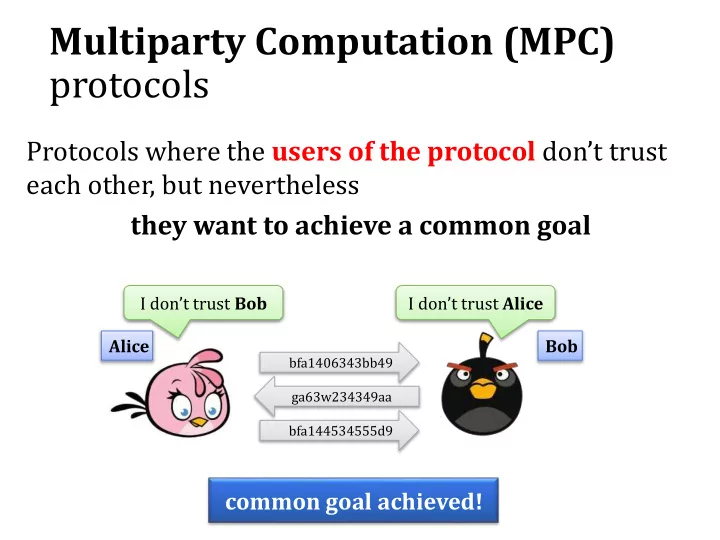

Multiparty Computation (MPC) protocols Protocols where the users of the protocol don’t trust each other, but nevertheless they want to achieve a common goal I don’t trust Bob I don’t trust Alice Alice Bob bfa1406343bb49 ga63w234349aa bfa144534555d9 common goal achieved!
With a “trusted third party” – it’s easy ideal world: A B Y Y But can we do it without a trusted third party? real world: bfa1406343bb49 ga63w234349aa bfa144534555d9 In other words: can we “simulate” the ideal world in the real world ?
The limitations partial • lack of fairness when there is no remedies honest majority exist (we will explain it in a moment), • no way to force the parties to provide beyond true input , the scope of crypto • and to respect the outcome .
Our idea Deal with these problems using Bitcoin
Example: Two party lotteries bfa1406343bb49 ga63w234349aa bfa144534555d9 • a random party earns 1 BTC • the other one looses 1 BTC
Looks similar to the “coin - tossing problem”. bfa1406343bb49 ga63w234349aa bfa144534555d9 output: Y Y with probability 1/2 where Y = with probability 1/2
How to solve the coin-tossing problem? Idea Remember the old game: rock-paper-scissors ?
Alice Alice Bob draw wins wins Bob Alice Bob draw wins wins Alice Bob draw wins wins
Let’s simplify this game Alice A=0 A=1 Alice Bob B=0 wins wins Bob Bob Alice B=1 wins wins In other words: Alice wins iff A xor B = 0 .
Another way to look at it Bob Alice has an input A has an input B they should jointly compute x = A xor B (in a secure way)
What to do? random bit A random bit B x = A xor B x = A xor B Problem: A and B should be sent at the same time (e.g. if A is sent before B then a malicious Bob can set B := x xor A , where x is chosen by him).
How to guarantee this? Seems hard: the internet is not synchronous... A solution: bit commitments
Commitment schemes – an intuition a bit A Alice “commits herself to A ” A Alice sends a locked box to Bob [binding] from now Alice cannot change A , [hiding] but Bob doesn’t know A Alice can later send the key to Bob A Alice “opens the commitment ”
How does it solve the coin- flipping problem? chooses a random bit A A commits to A chooses a sends B random bit B output A xor B opens A output A xor B
Problem 1 How to force Alice to open the commitment? commits to A sends B opens A This is precisely the lack of fairness problem. It’s inherent to most of the interesting MPC protocols...
Problem 2 commits to A sends B opens A So what? You lost This is the problem of forcing the parties to respect the output . Even more inherent (it is present also in the “ ideal world ” solution)
Idea: force the parties to open their commitments using the “deposits” deposit: if Alice didn’t redeem commit , then Bob can do it after 1 day commits to bit A transaction commit • has value 1 BTC • can be redeemed by Alice • claiming the transaction requires revealing A
How can Alice commit to A ? post on the blockchain : some earlier transaction of Alice can be spent using Alice ’s signature and (A,X) such that Y = H(A,X) Alice’s 1 Commit = T BTC or signature both signatures of Alice and Bob send to Bob a Refund transaction: Alice’s signature can be spent using Bob’s 1 Commit Refund = BTC signature after 1 day
This solves the problem of the lack of fairness! commits with a Bitcoin- based commitment to A sends B If Alice does not open her commitment opens A within 1 day then Bob can get her 1 BTC by posting the Refund Otherwise she gets transaction with his her 1 BTC back. signature
What about the problem of respecting the outcome? This can also be solved. Main idea: commits with a Bitcoin-based commitment to A commits with a Bitcoin-based commitment to B a transaction that takes the opening of the committed values and “decides” who won prob. 1/2
“Murder contract” 1,000 BTC if Bob provides a proof that Carol is murdered during the Alice Bob next hour Question : what if Bob is just lucky and Carol was murdered by someone else?
Solution: add some details 1,000 BTC if Bob provides a proof that Carol is murdered during the next hour using a .44 Alice Bob Remington Magnum gun
How a such a “proof” can look like ? Examples : • signed article from some press agency, • “ authenticated data feed ”, • several sources combined
Example 1,000 BTC if Bob provides an article containing texts: • “ Carol was murdered” Alice • “. 44 Remington Magnum Bob gun” signed by Associated Press
Two technical problems 1. such conditions are impossible to express using Bitcoin syntax 2. a separate “contract” is needed for every potential hitman Solution : a currency designed for doing contracts.
Features • has a concept of a “ contract ’’ that can be posted on the public register, and give money to anyone who provides some “solution” • allows to create arbitrarily complicated contracts .
Recommend
More recommend